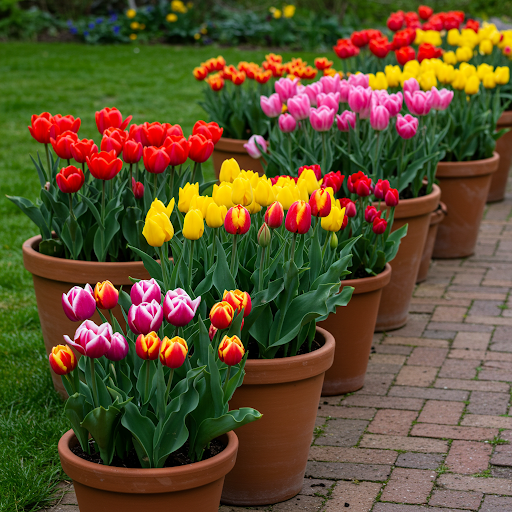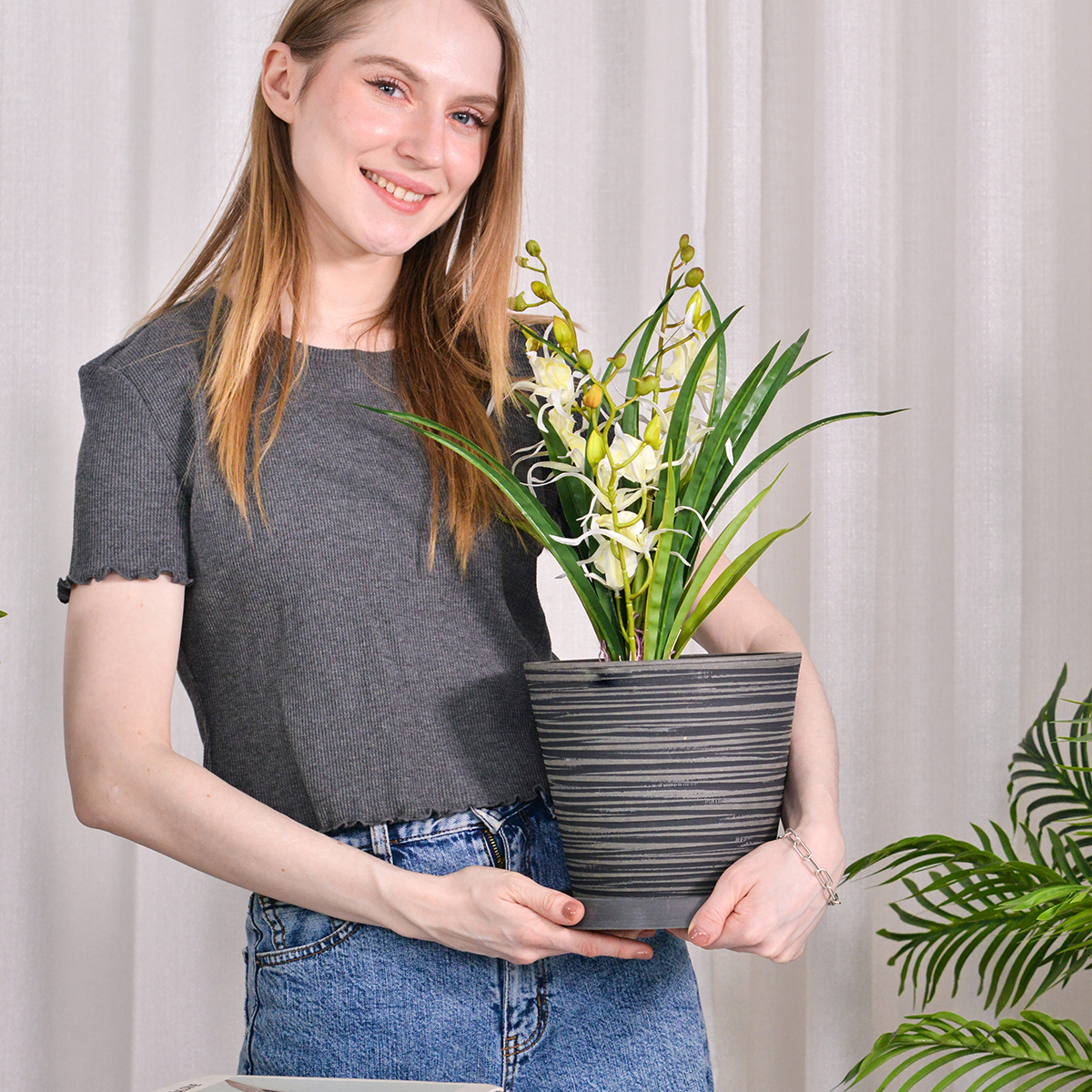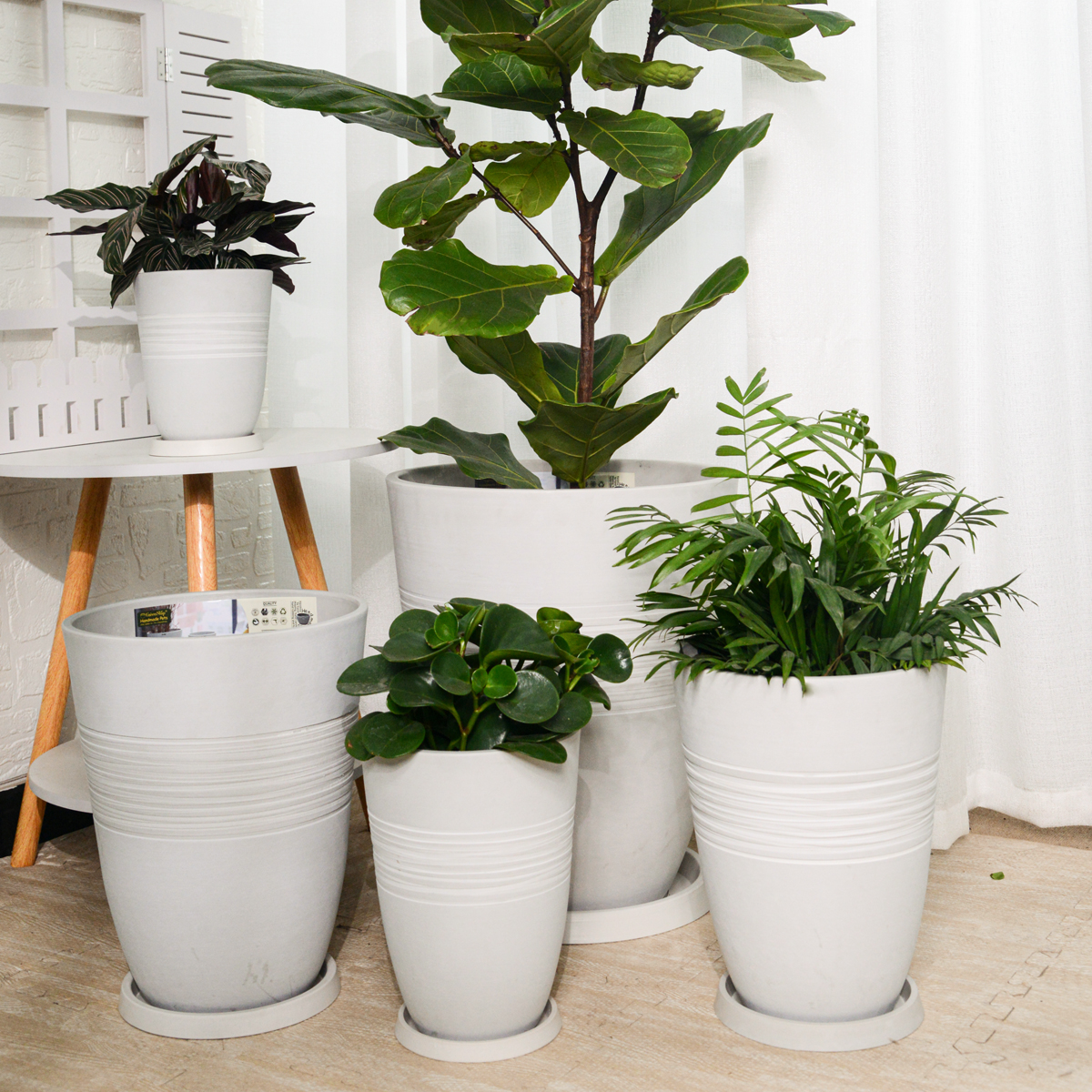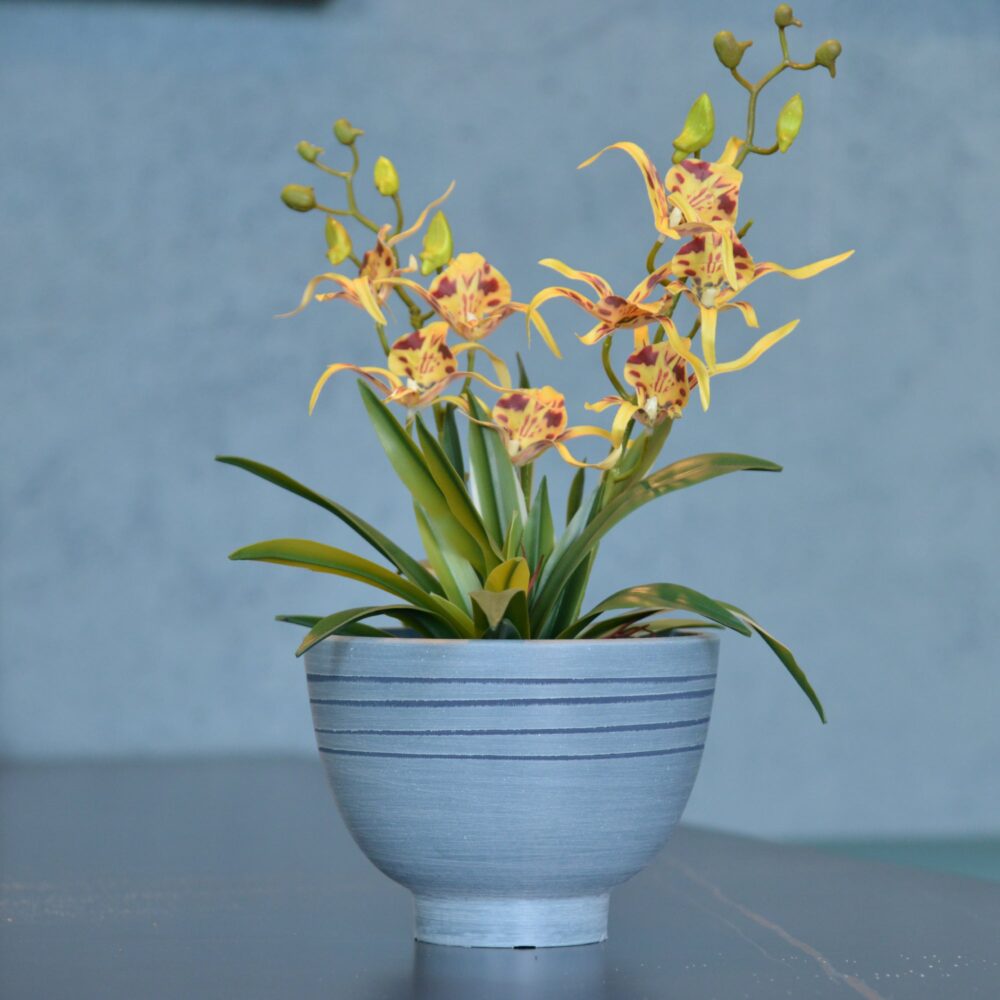Tulips in Pots: The Complete Guide to Growing Springtime Blooms Outdoors in Containers (Even in Warm Climates)
Want to bring the vibrant colors and classic springtime beauty of tulips to your patio, balcony, or garden, even in a warmer climate like Singapore? Growing tulips in containers is a fantastic way to enjoy these iconic spring flowers, offering flexibility and control over their growing conditions. Celebrated for their diverse colors, shapes, and sizes, their cheerful springtime blooms, and their adaptability to container gardening, tulips can bring a touch of classic spring charm to your outdoor living spaces, even if spring isn’t traditionally part of your local seasons. This comprehensive guide will provide you with everything you need to know to grow tulips successfully in outdoor pots, from selecting the best varieties and containers to mastering essential care techniques for a vibrant display of tulip blooms. Note for Singapore and warm climate gardeners: Growing tulips in warm climates like Singapore presents unique challenges due to the need for a chilling period. This guide will address these challenges and offer strategies for success.

tulips
What are Tulips?
Tulips are bulbous spring-blooming perennial herbaceous plants in the lily family (Liliaceae). They are native to a wide area spanning Southern Europe, North Africa, and Asia, from Anatolia and Iran to Northeast China and Japan. Tulips are popular spring-flowering bulbs grown for their brightly colored, cup-shaped flowers, upright growth habit, and classic springtime beauty. Tulip plants are characterized by their bulbous roots, strap-like leaves, sturdy stems, and single, cup-shaped flowers in a wide array of colors. They exhibit an upright, generally unbranched growth habit, typically reaching heights from dwarf 4 inches to tall 28 inches, depending on the variety and type. They are known for their vibrant spring colors, diverse flower shapes (single, double, fringed, lily-flowered, etc.), relatively easy planting (of bulbs), and iconic springtime association, making them a beloved addition to gardens and containers worldwide, especially for bringing early spring color after winter.
Are Tulips Good for Outdoor Pots?
Yes, tulips are exceptionally well-suited for outdoor pots and container gardening, and are in fact very commonly grown in containers, especially for springtime displays on patios, balconies, and decks. Their upright growth habit, manageable size, spectacular spring blooms, and adaptability to pot culture make them ideal for container gardens. Growing tulips in pots offers several advantages:
- Flexibility and Portability: Potted tulips can be easily moved to optimal locations for sunlight, display, or shelter during harsh weather. You can bring them to your patio when in bloom and then move them to a less prominent location after flowering.
- Controlled Environment: Container gardening allows you to provide the ideal well-draining soil mix that tulips need and control watering more precisely, which is especially important in climates with wet springs.
- Forcing Blooms: Potted tulips are easier to “force” for early indoor blooms (though this is less relevant for outdoor container gardening, but can be done in a cool room).
- Protection from Pests and Diseases: Container growing can help reduce some soilborne pest and disease issues that can affect tulips in the ground.
- Ideal for Small Spaces: Tulips in pots are perfect for patios, balconies, and small gardens where space is limited.
- Seasonal Displays: Tulips are naturally seasonal, and growing them in pots allows you to easily change out displays with other seasonal plants after they finish blooming.
Ideal Growing Conditions for Tulips in Pots (and Addressing Warm Climates):
Types of Tulips for Pots: Many tulip types and varieties are suitable for pots, but consider your desired bloom time, height, flower color, and style when choosing:
- Early Blooming Tulips: (Single Early, Double Early) – Shorter stems, bloom early in the spring, good for forcing and containers. Examples: ‘ Couleur Cardinal’, ‘ Princess Irene’, ‘ Monte Carlo’, ‘ Abba’. These are often good choices for warmer climates as they may bloom before the heat becomes too intense.
- Mid-Season Blooming Tulips: (Triumph, Darwin Hybrid) – Mid-height, classic tulip shapes, wide color range, reliable bloomers. Examples: ‘ тюльпан Apeldoorn’, ‘ тюльпан Leen van der Mark’, ‘ тюльпан Pink Impression’, ‘ тюльпан Blushing Apeldoorn’. Triumph tulips are very versatile for pots. Darwin Hybrids are known for large blooms and strong stems.
- Late Blooming Tulips: (Single Late, Double Late/Peony, Lily-Flowered, Fringed, Viridiflora, Parrot) – Taller stems, bloom later in the spring, often more elaborate flower shapes. Examples: ‘ тюльпан Queen of Night’, ‘ тюльпан Menton’, ‘ тюльпан Angelique’, ‘ тюльпан Ballade’, ‘ тюльпан China Town’, ‘ тюльпан Flaming Parrot’. Late tulips can extend the bloom season, but may be less suitable for very warm climates as they bloom later into potentially hotter weather.
- Dwarf Tulips: ( Tulipa kaufmanniana, Tulipa greigii, Tulipa fosteriana) – Shorter stems (4-10 inches), early to mid-season bloom, often with patterned foliage, excellent for small pots, rock gardens, and front of borders. Examples: Tulipa kaufmanniana ‘ тюльпан Johann Strauss’, Tulipa greigii ‘ тюльпан Red Riding Hood’, Tulipa fosteriana ‘ тюльпан Purissima’. Dwarf tulips are well-suited for smaller containers and may be more tolerant of warmer conditions due to their shorter growth cycle.
- Species Tulips (Wild Tulips): (Tulipa bakeri, Tulipa tarda, Tulipa turkestanica) – Smaller, more naturalistic forms, often more perennializing (returning for multiple years), good for naturalizing and pots. Examples: Tulipa bakeri ‘Lilac Wonder’, Tulipa tarda, Tulipa turkestanica. Species tulips are often more adaptable and may be worth trying in warmer climates.
Chilling Requirement (Crucial for Singapore and Warm Climates): Tulips require a period of cold temperatures (chilling hours) to bloom properly. Most tulip varieties need 12-16 weeks of chilling at temperatures between 35-45°F (2-7°C). Singapore’s warm climate does not naturally provide these chilling hours. To grow tulips successfully in Singapore and similar warm climates, you MUST pre-chill the tulip bulbs artificially before planting.
- Pre-Chilling Bulbs: Purchase tulip bulbs from reputable suppliers. In Singapore, you will likely need to order bulbs online or from specialized importers. Upon receiving the bulbs, place them in the refrigerator (not freezer!) for 8-12 weeks (or the recommended chilling period for your chosen variety). Store bulbs in a paper bag or mesh bag in the crisper drawer of your refrigerator. Do not store bulbs with fruits like apples or pears, as these fruits release ethylene gas which can harm the bulbs.
- Timing of Chilling and Planting in Singapore: Start chilling bulbs in late October or November for blooms in January to March (adjust timing based on desired bloom period and variety). After the chilling period, plant the bulbs in containers.
- Variety Selection for Warmer Climates: While chilling is essential, some tulip varieties may be slightly better suited to warmer climates than others. Early blooming varieties and species tulips may be more successfulas they have a shorter growth cycle and may bloom before the weather becomes too hot. Experiment with different types and see what performs best in your specific microclimate.
Light: Tulips need full sun during their growing and blooming period. They require at least 6-8 hours of direct sunlight per day to develop strong stems and vibrant flowers. Choose a sunny location for your tulip containers, such as a south-facing patio, balcony, or garden roof. In partial shade, tulip stems may become weak and leggy, and blooms may be smaller or less vibrant. Full sun is crucial for robust growth and best flower color.
Soil: Tulips need well-draining soil that is fertile and slightly acidic to neutral. Use a high-quality potting mixspecifically formulated for bulbs or a general-purpose potting mix amended for drainage. Amend potting mix with perlite, coarse sand, or grit to improve drainage and aeration, which is essential for bulbs to prevent rot. Avoid heavy, waterlogged soil. A slightly acidic to neutral pH (around 6.0-7.0) is ideal for tulips.
Watering: Tulips need moderate and consistent moisture during their active growth period in spring. Water thoroughly after planting to settle the soil. Water again when the top inch of soil feels slightly dry during the growing season, especially as shoots emerge and buds develop. Water deeply until water drains out of the drainage holes. Avoid overwatering and soggy soil, which can cause bulb rot. Allow the topsoil to dry slightly between waterings. Reduce watering after flowering as foliage begins to die back. In Singapore’s climate, be mindful of heavy rainfall and ensure pots have excellent drainage to prevent bulbs from sitting in waterlogged soil.
Temperature: Tulips are spring-blooming bulbs that thrive in cool spring temperatures. Ideal temperatures during their growing and blooming period are generally between 40-70°F (4-21°C). While Singapore’s temperatures are generally warmer, the pre-chilling process helps initiate the blooming cycle. Once planted after chilling, tulips will tolerate warmer temperatures during their relatively short growing and blooming period, especially if they are in a partially shaded location during the hottest part of the day. Avoid exposing potted tulips to excessively high temperatures above 85°F (29°C) for extended periods, which can shorten bloom time and stress the plants. If temperatures become very hot, move pots to a slightly cooler, shaded location during the hottest part of the day to prolong bloom.
Fertilizer: Tulips are not heavy feeders and generally do not require heavy fertilization, especially when grown in pots with good quality potting mix. Over-fertilizing can actually harm bulbs and promote weak growth. If desired, you can apply a light application of a balanced bulb fertilizer (e.g., 9-9-6 or 10-10-10) at planting time, mixing it into the soil at the bottom of the pot, below the bulbs, to avoid direct contact with the bulbs. Alternatively, you can apply a very dilute liquid fertilizer (half or quarter strength) once or twice as shoots emerge and buds begin to form. Avoid high-nitrogen fertilizers, which can promote leafy growth at the expense of blooms. In general, less fertilizer is better than too much for tulips in pots.
Choosing the Right Pots for Tulips:
Suitable Pot Types: Tulips are versatile and can be grown in various pot types, as long as drainage is excellent. Suitable pot types include:
- Terracotta Pots: Porous, allow good aeration and drainage, and aesthetically classic and charming, complementing the springtime beauty of tulips. Terracotta is a good choice for tulips as it helps prevent overwatering and provides good drainage.
- Ceramic Pots: Glazed or unglazed ceramic pots can be used, offering a wide range of decorative styles. Ensure they have drainage holes. Choose based on your desired aesthetic and drainage needs.
- Plastic Pots: Lightweight, inexpensive, and available in various colors and styles. Plastic pots are practical for tulips, especially for larger plantings, but be careful not to overwater as plastic retains moisture more than terracotta.
- Resin Pots: Lightweight, durable, available in styles mimicking terracotta or ceramic, and offer a balance of drainage and moisture retention. Resin pots are a good alternative to heavy ceramic or terracotta.
- Hyacinth Glasses or Bulb Vases (for forcing individual blooms, optional): Specialized glass vases designed for forcing bulbs like hyacinths and tulips in water. These are more for indoor forcing and less common for outdoor container displays, but can be used for individual tulip blooms.
Drainage: Excellent drainage is absolutely essential for tulips to prevent bulb rot. Ensure your chosen pot has drainage holes at the bottom. Avoid pots without drainage holes. Adding a layer of drainage material at the base of the pot (e.g., gravel, pot shards, clay pebbles) is often recommended to further improve drainage. Elevating pots slightly on pot feet or bricks can also improve drainage.
Pot Size: Choose pot sizes appropriate for the number of bulbs you want to plant and the type of tulips (dwarf vs. tall). Tulips can be planted relatively densely in pots for a fuller display.
- Small Pots (3-5 bulbs, Dwarf Tulips): For smaller displays of dwarf tulips or a few taller tulips, use pots that are at least 6-8 inches in diameter and at least 6-8 inches deep.
- Medium Pots (6-10 bulbs, Mixed Tulips): For a more substantial display of mixed tulip types or a larger group of taller tulips, use pots that are 10-14 inches in diameter or larger and at least 8-10 inches deep.
- Large Pots or Patio Containers (12+ bulbs, Mass Plantings): For mass plantings of tulips or for creating a dramatic display, use large pots or patio containers that are 14 inches in diameter or larger and at least 8-10 inches deep. Larger containers allow for more bulbs and better moisture retention.
- Depth: Tulips should be planted at a depth of about 4-6 inches from the base of the bulb to the soil surface, depending on bulb size (larger bulbs deeper). Ensure the pot is deep enough to accommodate this planting depth plus some space below the bulbs for root growth and drainage material.
Color and Style: Choose pot colors and styles that complement your tulip blooms and your outdoor décor, and enhance their cheerful springtime colors. Brightly colored pots in yellows, blues, greens, purples, or contrasting colors can enhance the vibrant colors of tulip blooms and create a festive spring display. Classic terracotta or white pots provide a more traditional and elegant look. Consider the overall style of your patio or garden and choose pots that harmonize with the surroundings, and enhance the springtime ambiance you wish to create.
Essential Care Tips for Thriving Tulips in Outdoor Pots (in Singapore and Warm Climates):
- Chilling Bulbs (Essential for Warm Climates): Pre-chill tulip bulbs in the refrigerator for 8-12 weeks before planting (or as recommended for your variety). This is crucial for bloom success in Singapore and similar climates.
- Planting Time (After Chilling): Plant chilled bulbs in pots in late December to January in Singapore for blooms in late January to March (adjust timing based on desired bloom period and variety). Plant bulbs pointed end up, at a depth of 4-6 inches.
- Watering: “Water After Planting, Then Water Sparingly Until Shoots Emerge, Then Water Moderately When Soil is Slightly Dry”. Water thoroughly after planting. Water sparingly until shoots emerge. Once shoots appear, water moderately when the top inch of soil feels slightly dry. Avoid overwatering and soggy soil. Reduce watering after flowering as foliage yellows.
- Sunlight: Provide Full Sun (6-8+ Hours Daily) During Growing Season. Place tulip pots in a location that receives full sun during their growing and blooming period.
- Fertilizing: Light Fertilizer at Planting (Optional), Very Dilute Feed (Optional). Fertilize sparingly, if at all. Light bulb fertilizer at planting (optional), or very dilute liquid feed once or twice as shoots and buds develop (optional). Avoid over-fertilizing.
- Deadheading (Prolong Bloom, Prevent Seed Set): Deadhead spent flowers as they fade by snipping off the flower head just below the bloom. This prevents seed formation and redirects energy back into the bulb, potentially prolonging bloom and improving bulb health for future years (though tulips are often treated as annuals in warmer climates). Leave foliage to die back naturally after flowering.
- Foliage Dieback (Allow Natural Dieback): After flowering, allow the foliage to die back naturally. Do not cut off green leaves, as they are needed to nourish the bulb for future growth (though in warmer climates, bulbs may not reliably rebloom). Once foliage has completely yellowed and dried, you can remove it.
- Bulb Storage (Optional, for Replanting in Cooler Climates – Less Relevant in Singapore): In cooler climates where tulips may perennialize, you can lift bulbs after foliage dieback, dry them, and store them in a cool, dry, dark place for replanting in the fall. In Singapore’s warm climate, tulip bulbs are generally treated as annuals and are discarded after blooming, as they may not rebloom reliably even if chilled again due to the lack of a natural cold winter dormancy period and potential for bulb rot in warm, humid conditions. Replanting fresh, pre-chilled bulbs each year is usually recommended for best results in warm climates.
- Pest and Disease Control: Monitor for common tulip pests and diseases, such as aphids, slugs, snails, bulb mites, and tulip fire (a fungal disease). Use organic pest and disease control methods if needed, such as insecticidal soap, diatomaceous earth, or copper fungicides. Good air circulation and proper watering practices help prevent many issues.
Popular Tulip Cultivars for Pots (by Type and Color):
- Early Blooming & Shorter (Good for Pots): ‘ Couleur Cardinal’ (Single Early, red), ‘ Princess Irene’ (Double Early, orange/purple), ‘ Monte Carlo’ (Double Early, yellow), ‘ Abba’ (Double Early, red dwarf), Tulipa kaufmanniana ‘ тюльпан Johann Strauss’ (Waterlily Tulip, red/yellow dwarf), Tulipa greigii ‘ тюльпан Red Riding Hood’ (Greigii Tulip, red dwarf).
- Mid-Season & Classic Shapes (Versatile for Pots): ‘ тюльпан Apeldoorn’ (Darwin Hybrid, red/yellow), ‘ тюльпан Leen van der Mark’ (Darwin Hybrid, red/white), ‘ тюльпан Pink Impression’ (Darwin Hybrid, pink), ‘ тюльпан Blushing Apeldoorn’ (Darwin Hybrid, yellow/red).
- Late Blooming & Elegant (For Larger Pots): ‘ тюльпан Queen of Night’ (Single Late, dark purple/black), ‘ тюльпан Menton’ (Single Late, pink/apricot), ‘ тюльпан Angelique’ (Double Late/Peony, pink/white), ‘ тюльпан Ballade’ (Lily-Flowered, purple/white), ‘ тюльпан China Town’ (Viridiflora, white/green/pink), ‘ тюльпан Flaming Parrot’ (Parrot Tulip, red/yellow).
- Species Tulips (More Natural Look, Potentially More Adaptable): Tulipa bakeri ‘Lilac Wonder’ (Bakeri Tulip, pink/yellow), Tulipa tarda (Tarda Tulip, yellow/white), Tulipa turkestanica (Turkestanica Tulip, cream/yellow).
- Color Mixes: Tulip mixes are widely available in various color themes (e.g., pastel mix, rainbow mix, red/yellow mix, etc.) and can be a convenient way to create colorful container displays.
In Summary (and for Singapore Gardeners):
Growing tulips in outdoor pots, even in warm climates like Singapore, is achievable and can bring the beauty of springtime blooms to your garden. The key to success in warm climates is artificial pre-chilling of the tulip bulbs for 8-12 weeks before planting. By choosing suitable pot types with excellent drainage, using a well-draining potting mix, providing full sun during the growing season, watering appropriately, and pre-chilling bulbs, you can cultivate vibrant tulip displays in containers. However, it’s important to understand that tulips are not naturally suited to tropical climates like Singapore and may be best treated as annuals, replanting fresh, pre-chilled bulbs each year for reliable blooms. Experiment with early blooming varieties and species tulips, and enjoy the unique challenge and reward of bringing a touch of springtime to your warm climate garden with potted tulips.

v
For more detailed botanical information and to explore the diverse world of Tulipa (tulips), you can visit the Wikipedia page on Tulip.
Important Note for Singapore and Warm Climate Gardeners: While this guide provides information on growing tulips in pots outdoors, success in warm climates like Singapore is highly dependent on proper pre-chilling of bulbs and careful attention to growing conditions. Tulips may not perennialize reliably in warm climates and are often treated as annuals. Manage your expectations and enjoy the beauty of tulips as a seasonal display each year by replanting fresh, pre-chilled bulbs. Always consult with local gardening experts and nurseries in Singapore for the most specific and regionally relevant advice on growing tulips and other spring bulbs in your area.
20VD
By greenship|2024-08-13T06:43:41+00:00August 13, 2024|Categories: Hand-carving Series|
K2-11T
By greenship|2024-08-13T04:21:25+00:00August 13, 2024|Categories: Hand-carving Series|
Planter 6 in W / 8 in W / 12 in W Indoor or Outdoor Plants, Modern Decorative Plant Pots with Drainage Hole, Decorative Flower Pots
By greenship-seo|2025-02-06T13:43:53+00:00January 16, 2025|Categories: Hand-carving Series|Tags: Decorative Flower Pots|
KC2-11VH
By greenship|2024-08-16T06:19:28+00:00August 16, 2024|Categories: Hand-carving Series|
k2-21G
By greenship|2024-08-13T06:17:26+00:00August 13, 2024|Categories: Hand-carving Series|
8 inch/10 inch Planter Indoor Plants, 2 Pack Modern Decorative Plant Pots with Drainage Hole, Cute Bowl Shape Flower Pots
By greenship-seo|2025-04-10T08:03:42+00:00January 9, 2025|Categories: Hand-carving Series|Tags: Decorative Flower Pots, Self-Watering Pots|






